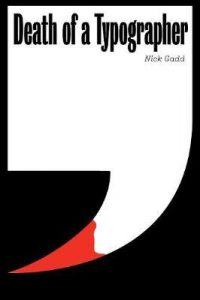
Book Review: Death of a Typographer by Nick Gadd (Arden 2019)
by Stephanie Holt
I wonder whether, years from now, we’ll remember with special affection books read during COVID-19 isolation. I’ll admit, I’ve been struggling to read deeply, instead devouring news and commentary through a fog of angst. But Nick Gadd’s Death of a Typographer has been a welcome exception. Both a piquant page-turner and an easily put-down, picked-up immersion, it made a perfect COVID-19 companion.
From the opening scene – a body arranged as a letter X, a character named Martin Kern – we realise we’re in for one big typography joke. Our type-designing protagonist sets about solving the murder of printer Tom Cremington. Along for the ride are grammar nut and crime reporter Lucy Tan and various obsessives clinging to a time when journalists boozed in dingy bars, lead type was set in inner-city workshops, and crimes were solved by sharply dressed wisecrackers.
Puns, in-jokes and type-related analogies abound. A mind is ‘as sharp as a hairline serif’, blood pools ‘as if someone had upset a bottle of deep magenta’; Lucy is likened to a favourite font (Peignot: ‘practical and elegant’ but also ‘playful, individualistic and maybe a little perverse’). Characters take typographic names: Virgona, Roman, Bodoni. Type detectives are dubbed typeshoes; crazed type aficionados, typopaths; impending doom, the Typocalypse.
This satisfyingly twisty mystery has a beautiful conceit at its heart. Kern is convinced it involves legendary Dutch type designer Pieter van Floogstraten. Floogstraten, an idealist whose work energised political posters, album covers and radical magazines, had disappeared in the mid ’70s. Is he, as rumoured, designing a perfect font? Are those his perfect letterforms, scattered across the world – a shop hoarding here, a graffito there? Have his global ramblings now brought him to Melbourne, to murder?
The story rolls along, in classic crime-fiction mode. There are clandestine gatherings with secret passwords (sorry, passfonts). There are chases and stakeouts, coded messages and dodgy assignations. Bodies pile up, and then the mystery gets solved, with a neat, nifty conclusion.
Much of this takes place in Melbourne’s inner suburbs, familiar locations lightly fictionalised. Recognising them is part of the fun. Kern, like Floogstraten, spends a lot of time wandering, noticing things others overlook. Ugly fonts – here’s trying not to look at you, Gargoyle and Comic Sans – make him ill. Faded signs and handwritten relics bring joy. (Gadd is an expert on the ghost signage of Melbourne, and these are lovingly evoked.)
Sensuous descriptions are punctuated by dialogue that ricochets around. Gadd shows a dab, satirical hand in such scenes. A workaholic’s seduction wastes neither time nor words (‘Monty nodded with approval. ‘Social life?’ / ‘Not really.’ / ‘Holidays?’ / ‘Not for ages.’ / Monty emptied her cocktail.’). A detective discovers the cliches of the creative (‘This character’s got a black skivvy on.’ / ‘Do you know how many designers wear …?’ / ‘Beret, too.’ / ‘OK, but still…’ / ‘And odd socks.’ / ‘Martin didn’t answer.’) Corporate jargon and professional pretensions cop a serve. Editors will enjoy some excruciating examples of overwriting (fixed by Lucy, of course) and linguistic obfuscation.
There’s a dilemma here, which you’ve probably spotted. As Lucy tells Martin, ‘You think because this guy makes beautiful fonts, he’s innocent.’ The story teases that tenuous connection between creativity, beauty and goodness – thought provoking, but never tendentious.
A book’s worth of type puns and typographic trivia might wear thin, but Death of a Typographer interweaves its murder mystery with Floogstraten’s backstory and tales of the secret alphabet. These are a delight. Words are often a solace in these little stories. A child learning the alphabet from his mother while hiding from the Nazis. A working-class bookshop clerk and aspiring writer in Thatcher’s Britain. A soccer-loving misfit of a teenage monk in a Tibetan monastery. A world-weary anthropologist, missing her wife, on a research and conferencing trip to Peru. Each is deftly drawn and intriguing.
Kern wants type to be ‘warm, humane, individual – a way to share poetry and politics, art and learning’. That’s an apt description of the book’s resonance. Perhaps, as we emerge from isolation, we’ll lean into those values and notice with renewed sensitivity and respect the quotidian details of our shared streets and cities.

Photo: Stephanie Holt
Photo credit: Tania Jovanovic
Stephanie Holt was until recently an editing teacher and – most recently – acting program manager with RMIT University’s Professional Writing and Editing programs, but is now looking forward to post-RMIT, post-ISO freelance projects and hanging out in second-hand book shops again.
